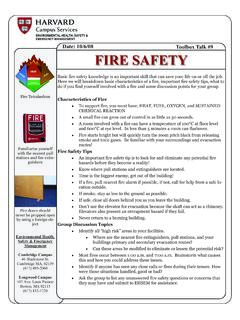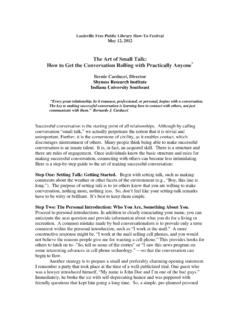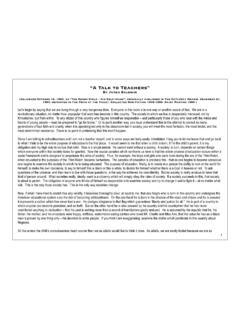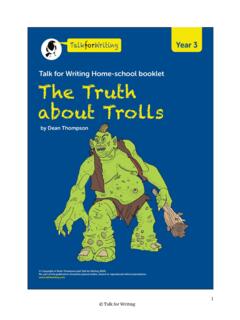Transcription of Poor Police–Community Relations
1 poor police CommunityRelations8 CHAPTER115 IntroductionThere are many reasons why the police have difficult interactions with thecommunities they are supposed to serve and protect. Many of these stemfrom the fact that overall, police departments have contrasting perspectives, poor communications, and concerns about the nature of social control in afree society (Radalet and Carter, 1994, p. 7). The police deal with the community on several levels: individually, as agroup/organization, and as political actors. When it appears that lawenforcement represents the interests of the communities in which theypolice, there is general harmony. When police are out of sync with thesesentiments, there is discontent and dissention. Also, keep in mind that Dif-ferent community groups view the police differently and have varyingnotions of the priorities and objectives of law enforcement and criminal jus-tice (Cordner and Scarborough, 2007: 10).
2 Also, difficulty at one level ofthe interaction can have repercussions at chapter defines police community Relations ; distinguishes it frompublic Relations , community service, and community participation; reviewsthe history of improving police community Relations ; and then analyzes thestrategies of community policing and problem-solving policing. The remain-ing portion examines how community policing can be easily misused andwhat to do to put it back on IssuesThere are a considerable number of definitions for police community rela-tions. Nevertheless, this term generally refers to the sum total of attitudesand behaviors between police and the communities they serve. They canrange from positive to negative in general or with respect to particular thingspolice do. One of the ways that police community Relations has been under-stood (and defined) is by seeing it as part of a tripod, including public rela-tions, community service, and community participation (Radalet andCarter, 1994).
3 Taken as a whole this conceptualization makes 12/9/10 8:55 AM Page 115116 Chapter 8 poor police community RelationsHowever, if one of these component parts is all there is, police communityrelations can be quite problematic. Public Relations Many times police community Relations is primarily the practice of publicrelations, which is a collection of communication techniques used by indi-viduals or organizations to convince an audience about the merits of an idea,organization, program, practice, or policy. Public Relations tries to convincean audience based on appeals to reason. Despite what might appear to be aninnocuous kind of communication, the public Relations process tends to beone way from the police department to citizens. And if the community isconsulted, sometimes only selected constituencies ideas or preferences aretaken into account ( , addressed), thus upsetting those who were ignoredand/or left problem here is that what a police department views as good for thedepartment may not necessarily be good for the community ; or it may begood only for that part of the community to whom the police are particularlyresponsive and not for other parts (Radalet and Carter, 1994, p.)
4 31). community ServiceAlternatively, community service refers to the activities whereby policeengage in prosocial activities to enhance the well-being of the communitybeyond law enforcement and order maintenance. Examples include run-ning a police Athletic League or night basketball league. community ser-vice can provide a public Relations benefit. Frequently the words andexpressions public relationsand community relationsare used interchange-ably. But in reality, there is a difference between the two. Although publicrelations was defined earlier in this book, a community Relations program isbest seen as a long-range, full scale effort to acquaint the police and thecommunity with each other s problems and to stimulate action aimed atsolving those problems (Radalet and Carter, 1994, p. 31). community ParticipationFinally, community participation involves members of the community tak-ing an active role in trying to genuinely help the police .
5 It is the widelyused social work concept of community organization, with particular atten-tion to the pivotal responsibility of the police and other criminal justiceagencies (Radalet and Carter, 1994, p. 34). In the end police community Relations is a process where the entirepolice department (not a specialized unit) is engaged with the communitiesthey serve in order to make it a safe and better place to live (Radalet andCarter, 1994, p. 32). 12/9/10 8:55 AM Page 116 Emergence of the Problem of poor police community Relations117 Importance of police community RelationsWhen there is good police community Relations , police have a better under-standing of the public s concerns (especially those that are crime related),and citizens are more inclined to report crimes that occur to the police , provide tips/intelligence to law enforcement, willingly serve as witnesses,and are happy to participate in jury trials.
6 By extension, police also becomemore proactive, thereby preventing crimes before they occur or minimizingtheir impact, instead of simply reacting to calls for service. Good police community Relations prevent the possibility that the public thinks that policeare simply a mechanism for intelligence there are poor police community Relations , the police typicallylack a basic understanding of community problems, goals, and desires, andthe community , particularly those citizens who are experiencing high ratesof crime, poverty, and homelessness, perceive police as an occupying andout-of-touch force that does more harm than good. In these situations, police departments primarily assume a reactive mode of response to com-munity problems. In sum, police community Relations refers to the ongoing and changingrelationship between the police and the communities they serve. Thisincludes issues of cooperation, race Relations , fear of police , violence, andcorruption.
7 Emergence of the Problem of poor police community Relations The notion of police community Relations derives from Sir Robert Peel sprinciples of law enforcement. As you may recall, before the creation of thefirst modern police department, it was the duty of every able-bodied personto take their turn at the watch, thereby contribute to the policing of theircommunity. If there was a threat to the community , the night watch wouldraise a hue and cry. This would wake up the community , and its citizenswould collectively repel an attack from wild animals or intruders, help putout a fire, and so on. Why did this break down?Early History of police community RelationsDevelopments during the early part of the 20th century ( , the advent ofmotorized vehicles, the development of more efficient mass transportation sys-tems, police officers not living in the same jurisdiction in which they patrolled)led to a breakdown in police community Relations .
8 In short, there are numer-ous reasons for poor police community Relations . These can include: Socialization of children by parents to fear/distrust the police Hostility toward the 12/9/10 8:55 AM Page 117118 Chapter 8 poor police community Relations Confidence in police ability has decreased Less contact by police with citizens Bad cops (rude, corrupt, violent) Some veteran officers would rather not deal with the community police are not the best communicators police and citizens have different perspectives on how crime iscaused and how to respond to factors in whole or in part prompted police reformers to search forappropriate solutions. One of the more notable was the integration of thehuman Relations movement into law enforcement The human relationsmovement and some astute police executives believed that police had tomove beyond simply being responsible for enforcing the law and actuallyconnect with the communities they policed (Radalet and Carter, 1994, p.)
9 23). Some of the initial attempts to increase awareness and techniques ofpolice community Relations were started with the introduction of humanrelations training into police training academies (Radalet and Carter, 1994;Bayley and Mendelsohn, 1969). Human Relations consisted of a series oftechniques to both better understand how individuals behaved in groupsand to improve their productivity and cooperation in World War II, there was a fledgling interest in human relationstraining for police officers and the communities they policed (Radalet andCarter, 1994, p. 23). police administrators interested in having their depart-ments improve interactions with the communities they police occasionallysent officers to summer workshops that were led by organizations such as theNational Conference of Christians and Jews (NCCJ). A few police officersenrolled in these workshops as early as 1947, seeking help in understandinghuman Relations or in setting up departmental training programs on the sub-ject (Radalet and Carter, 1994, p.
10 23). In 1954, in Philadelphia, the Inter-national Association of Chiefs of police and the National Association ofIntergroup Relations Officials sponsored a two-day conference for policeexecutives and other professionals involved in human National Institute on police and community RelationsIn 1955, based on the relative success of these initiatives, through the com-bined efforts of the NCCJ and the Michigan State University (MSU) Schoolof police Administration and Public Safety, the National Institute on Policeand community Relations (NIPCR) was formed. The NIPCR s traininginvolved workshops and/or institutes. The institute, a five-day conference,proved to be so popular that it was repeated each May until 1970. It broughttogether teams of police officers and other community leaders to discusscommon problems and to develop leadership for similar programs at thelocal or state levels (Radalet and Carter, 1994, p.


















